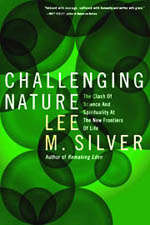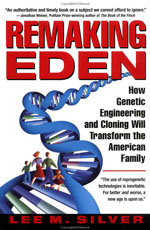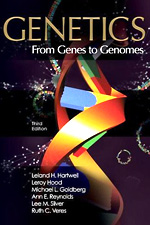|
published by Ecco/Harper Collins, 2006
|
|
Books
Presentations
Publications/Writings
Biography
Princeton Courses
|
The cost of dietary protein
The problem is that—unlike cows, goats, and sheep—farmed pigs cannot extract sufficient phosphorus from the corn and other grains they are fed. Grains actually contain plenty of phosphorus, but it is mostly locked away in a large chemical called phytate, which is inaccessible to digestion by animal enzymes. Ruminants release the phosphorus during a lengthy digestive process in four stomachs, with the help of symbiotic bacteria.
To survive, the pig's wild ancestors depended on a varied diet, including worms, insects, lizards, roots, and eggs. But pig farming is most efficient with a simpler all-grain diet, supplemented with essential minerals. Although this feeding strategy works well for the animals, the inaccessible phosphorus in the grain passes entirely into the manure, which farmers use as crop fertilizer or otherwise distribute onto the land.
Today, in most rich and poor countries alike, pigs provide more dietary protein more cheaply and to more people than any other animal. Worldwide, pork accounts for 40% of total meat consumption.11 While northern Europe still maintains the highest pig-to-human ratio in the world (2 to 1 in Denmark), the rapidly developing countries of east Asia are catching up. During the decade of the 1990s alone, pork production doubled in Vietnam and grew by 70% in China.
Along the densely populated coastlines of both countries, pig density exceeds 100 animals per square kilometer, and the resulting pollution is "threatening fragile coastal, marine habitats including mangroves, coral reefs, and sea grasses."7 As the spending power of people in developing Asian countries continues to rise, pig populations will almost certainly increase further.
Pig-caused ecological degradation is a complex problem, and no single solution is in the offing. But any approach that allows even a partial reduction in pollution should be subject to serious consideration by policy makers and the public.
A prototypical example of what directed genetic modification (GM) technology can deliver is the transgenic Enviropig, developed by Canadian biologists Cecil Forsberg and John Phillips. Forsberg and Phillips used an understanding of mammalian gene regulation to construct a novel DNA molecule programmed for specific expression of the E. coli phosphorus-extraction gene (phytase) in pig saliva. They then inserted this DNA construct into the pig genome.8
The results obtained with the first generation of animals were dramatic: the newly christened Enviropigs no longer required any costly dietary supplements and the phosphorus content of their manure was reduced by up to 75%. Subtle genetic adjustments could yield even less-polluting pigs, and analogous genetic strategies can also be imagined for eliminating other animal-made pollutants, including the methane released in cow belches, which is responsible for 40% of total greenhouse gas emissions from New Zealand.5
Enzymes in natural bacteria
An added advantage with the Enviropig is that the single extra enzyme in its saliva is also present naturally in billions of bacteria inhabiting the digestive tract of every normal human being. As bacteria continuously die and break apart, the naked enzyme and its gene both float free inside us without any apparent consequences, suggesting that the Enviropig will be as safe for human consumption as non-GM pigs. If the enzyme happened to escape into meat from modified pigs, it would be totally inactivated by cooking.
New varieties of animals with natural mutations undergo no safety testing at all.
Of course, empirical analysis is required to show that the modification does not make the meat any more harmful to human health than it would be otherwise. With modern technologies for analyzing genomes, transcriptosomes, proteomes, and metabolomes, any newly constructed transgenic animal can be analyzed in great molecular detail. "Isn't it ironic," Phillips and Forsberg commented13, "that new varieties of animals with extreme but natural mutations undergo no safety testing at all?"
Environmentally friendly GM
Not all GM projects are aimed specifically at reducing the harmful effects of traditional agriculture on the environment. Other GM products approved to date, developed almost entirely in the private sphere, have aimed to reduce production costs on large-scale farms. But as molecular biology becomes ever more sophisticated, the universe of potential environmentally friendly GM applications will expand.
Scientists have begun research toward the goal of obtaining pigs modified to digest grasses and hay, much as cows and sheep do, reducing the land and energy-intensive use of corn and soy as pig feed. Elsewhere, trees grown on plantations for paper production could be made amenable to much more efficient processing. This would reduce both energy usage and millions of tons of the toxic chemical bleach in effluents from paper mills.3,14
The most significant GM applications will be ones that address an undeniable fact: every plot of land dedicated to agriculture is denied to wild ecosystems and species habitats. And that already amounts to 38% of the world's landmass. Genetic modifications that make crop production more efficient would give us opportunities to abandon farmland that, in many cases, should cede it back to forests and other forms of wilderness, as long as world population growth is ameliorated.
So why are many environmentally conscious people so opposed to all uses of GM technology? The answer comes from the philosophy of organic food promoters, whose fundamental principle is simply stated: natural is good; synthetic is bad.16
The roots of organic farming
Before the 18th century, the material substance of living organisms was thought to be fundamentally different—in a vitalistic or spiritual sense—from that of nonliving things. Organisms and their products were organic by definition, while nonliving things were mineral or inorganic. But with the invention of chemistry, starting with Lavoisier's work in 1780, it became clear that all material substances are constructed from the same set of chemical elements.
As all scientists know today, the special properties of living organic matter emerge from the interactions of a large variety of complex, carbon-based molecules. Chemists now use the word organic to describe all complex, carbon-based molecules—whether or not they are actually products of any organism.
Through the 19th and 20th centuries, increased scientific understanding, technological innovations, and social mobility changed the face of American agriculture. Large-scale farming became more industrialized and more efficient. In 1800, farmers made up 90% of the American labor force; by 1900, their proportion had decreased to 38%, and in 1990, it was only 2.6%.
However, not everyone was happy with these societal changes, and there were calls in the United States and Europe for a return to the preindustrial farming methods of earlier times. This movement first acquired the moniker organic in 1942, when J. I. Rodale began publication in America of Organic Farming & Gardening, a magazine still in circulation today.
According to Rodale and his acolytes, products created by—and processes carried out by—living things are fundamentally different from lab-based processes and lab-created products. The resurrection of this prescientific, vitalistic notion of organic essentialism did not make sense to scientists who understood that every biological process is fundamentally a chemical process. In fact, all food, by definition, is composed of organic chemicals. As a result, the U.S. Department of Agriculture (USDA) refused to recognize organic food as distinguishable in any way from nonorganic food.
Legislating meaning
In 1990, lobbyists for organic farmers and environmental groups convinced the U.S. Congress to pass the Organic Foods Production Act, which instructed the USDA to establish detailed regulations governing the certification of organic farms and foods.2 After 12 years of work, the USDA gave organic farmers the certification standards that they wanted to prevent supposed imposters from using the word organic on their products.15 Similar organic standards have been implemented by the European Commission and by the Codex Alimentarius Commission of the United Nations.4,6
In all instances, organic food is defined not by any material substance in the food itself, but instead by the socalled natural methods employed by organic farmers. The USDA defines organic in essentially negative terms when it says, "the [organic] product must be produced and handled without the use of synthetic substances" and without the use of synthetic processes. The Codex Commission explains in a more positive light that "organic agriculture is a holistic production management system."
The physical attributes of organic products—and any effects they might have on the environment or health—are explicitly excluded from the definition. Nonetheless, the definitions implicitly assume that organic agriculture is by its very nature better for the environment than conventional farming.
The European Commission states as a fact that "organic farmers use a range of techniques that help sustain ecosystems and reduce pollution." Yet, according to self-imposed organic rules, precision genetic modification of any kind for any purpose is strictly forbidden, because it is a synthetic process. If conventional farmers begin to grow Enviropigs—or more sophisticated GM animals that reduce nearly all manure-based pollution—organic pig farmers will then blindly continue to cause much more pollution per animal, unless they are prevented from doing so by future EPA regulations.
Many organic advocates view genetic engineering as an unwarranted attack not just on the holistic integrity of organic farms, but on nature as a whole. On the other hand, spontaneous mutations caused by deep-space cosmic rays are always deemed acceptable since they occur "naturally." In reality, laboratory scientists can make subtle and precise changes to an organism's DNA, while high-energy cosmic rays can break chromosomes into pieces that reattach randomly and sometimes create genes that didn't previously exist.
Regardless, organic enthusiasts maintain their faith in the beneficence and superiority of nature over any form of modern biotechnology. Charles Margulis, a spokesman for Greenpeace USA, calls the Enviropig "a Frankenpig in disguise."12
Chemical pesticides and organic farming
Although the market share held by organic products has yet to rise above single digits in any country, it is growing steadily in Europe, the United States, and Japan. Nearly all consumers assume that organic crops are, by definition, grown without chemical pesticides. However, this assumption is false.
Pyrethrin (C21H28O3), for example, is one of several common toxic chemicals sprayed onto fruit trees by organic farmers—even on the day of harvesting. Another allowed chemical, rotenone (C23H22O6), is a potent neurotoxin, long used to kill fish and recently linked to Parkinson's disease.1,10
How can organic farmers justify the use of these and other chemical pesticides? The answer comes from the delusion that substances produced by living organisms are not really chemicals, but rather organic constituents of nature. Since pyrethrin is produced naturally by chrysanthemums and rotenone comes from a native Indian vine, they are deemed organic and acceptable for use on organic farms.
The most potent toxins known to humankind are all-natural and organic.
However, the most potent toxins known to humankind are all natural and organic. They include ricin, abrin, botulinum, and strychnine—highly evolved chemical weapons used by organisms for self-defense and territorial expansion. Indeed, every plant and microbe carries a variety of mostly uncharacterized, more or less toxic attack chemicals, and synthetic chemicals are no more likely to be toxic than natural ones.
Less-allergenic GM food
All currently used pesticides—both natural and synthetic—dissipate quickly and pose a miniscule risk to consumers. Nevertheless, faith in nature's beneficence can still be fatal to some children. About 5% express severe allergic reactions to certain types of natural food. Every year unintentional ingestion causes hundreds of thousands of cases of anaphylactic shock with hundreds of deaths.
The triggering agents are actually a tiny number of well-defined proteins that are resistant to digestive fluids. These proteins are found in such foods as peanuts, soybeans, tree nuts, eggs, milk, and shellfish. They linger in the intestines long enough to provoke an allergic immune response in susceptible people.
No society has been willing to ban the use of any allergenic ingredients in processed foods, even though this approach could save lives and reduce much human suffering. GM technology could offer a more palatable alternative: scientists could silence the specific genes that code for allergenic proteins. The subtly modified organisms would then be tested, in a direct comparison with unmodified organisms, for allergenicity as well as agronomic and nutritional attributes.
USDA-supported scientists have already created a less-allergenic soybean. Soy is an important crop used in the production of a variety of common foods, including baby formula, flour, cereals, and tofu. Eliot Herman and his colleagues embedded a transgene into the soy genome that takes advantage of the natural RNA interference system to turn off the soy gene responsible for 65% of allergic reactions.9
RNA interference can be made to work in a highly specific manner, targeting the regulation of just a single gene product. Not only was the modified soy less allergenic in direct tests, but the plants grew normally and retained a complex biochemical profile that was unaltered except for the absence of the major allergen. Further rounds of genetic surgery could eliminate additional allergenic soy proteins. Other scientists have reported promising results in their efforts to turn off allergy-causing genes in peanuts and shrimp.
Some day perhaps, conventional soy and peanut farmers will all switch production to low-allergenicity GM crop varieties. If that day arrives, organic food produced with GM-free organic soy or peanuts will be certifiably more dangerous to human health than comparable nonorganic products.
Unfortunately, conventional farmers have no incentive to plant reduced-allergy seeds when sales of their current crops are unrestricted, especially when the public has been led to believe that all genetic modifications create health risks. In the current social and economic climate, much of the critical research required to turn promising results into viable products is simply not pursued. Anti-GM advocates for organic food may be indirectly and unknowingly responsible for avoidable deaths in the future.
Vegetarian meat
Only three decades have passed since genetic modification technology was first deployed in a rather primitive form on simple bacteria. The power of the technology continues to explode with no end in sight, leading to speculation about how agriculture could really be transformed in the more distant future.
Chicken meat is actually cooked muscle, and muscle is a type of tissue with a particular protein composition and a particular structure. At some future date, as the power of biotechnology continues to expand, our understanding of plant and animal genes could be combined with the tools of genetic modification to create a novel plant that grows appendages indistinguishable in molecular composition and structure from chicken muscles.
Vegetative chickens—or perhaps muscular vegetables—could be grown just like other crops. Eventually, there could be fields of chicken, beef, and pork plants. At harvest time, low-fat boneless meat would be picked like fruit from a tree.
The advantages of genetically engineered vegetative meat are numerous and diverse. Without farm animals, there could be no suffering from inhumane husbandry conditions and no pollution from manure. Since the sun's rays would be used directly by the plant to make meat, without an inefficient animal intermediate, far less energy, land, and other resources would be required to feed people.
Up to 20% of the earth's landmass currently used for grazing or growing animal feed might be ceded back to nature for the regrowth of dense forests. As a result, biodiversity would expand, the extinctions of many species might be halted, and a large sink for extracting greenhouse gases from the atmosphere might be created.
Of course, this scenario is wild biotech speculation. But current-day organic advocates would reject any technology of this kind out of hand, even if it was proven to be beneficial to people, animals, and the biosphere as a whole. This categorical rejection of all GM technologies is based on a religious faith in the beneficence of nature and her processes under all circumstances, even when science and rationality indicate otherwise.
References
1. Betarbet, R., T. B. Sherer, G. MacKenzie et al. 2000. Chronic systemic pesticide exposure reproduces features of Parkinson's disease. Nature Neuroscience 3: 1301-1306.
2. Burros, M. 2002. A definition at last, but what does it all mean? New York Times (Oct 16).
3. Chiang, V. L. 2002. From rags to riches. Nature Biotechnology 20: 557-558.
4. Codex Alimentarius Commission. 1999. Guidelines for the Production, Processing, Labeling and Marketing of Organically Produced Foods. U.N. Food and Agriculture Organization, Rome
5. Dennis, C. 2004. Vaccine targets gut reaction to calm livestock wind. Nature 429: 119.
6. EUROPA. 2000. What Is Organic Farming? European Commission, Belgium.
7. FAO. 2006. Livestock Policy Brief 02: Pollution from Industrialized Livestock Production. U.N. Food and Agriculture Organization, Rome
8. Golovan, S. P., R. G. Meidinger, A. Ajakaiye et al. 2001. Pigs expressing salivary phytase produce low-phosphorus manure. Nature Biotechnology 19: 741-745.
9. Herman, E. M., R. M. Helm, R. Jung & A. J. Kinney. 2003. Genetic modification removes an immunodominant allergen from soybean. Plant Physiology 132: 36-43.
10. Isman, M. B. 2006. Botanical insecticides, deterrents, and repellents in modern agriculture and an increasingly regulated world. Annual Review of Entomology 51: 45-66.
11. OECD. 2003. Agriculture, trade and the environment: the pig sector. OECD Observer (Sep).
12. Osgood, C. 2003. Enviropigs may be essential to the future of hog production. Osgood File (Aug 1). CBS News, New York.
13. Personal communication.
14. Pilate, G., E. Guiney, K. Holt et al. 2002. Field and pulping performances of transgenic trees with altered lignification. Nature Biotechnology 20: 607-612.
15. USDA. 2000. National Organic Program. U.S. Department of Agriculture, Washington, DC.
16. Verhoog, H., M. Matze, E. Lammerts van Bueren & T. Baars. 2003. The role of the concept of the natural (naturalness) in organic farming. Journal of Agricultural and Environmental Ethics 16: 29-49.
Lee M. Silver is professor of molecular biology in the Woodrow Wilson School of Public and International Affairs at Princeton University, and the author of Challenging Nature: The Clash of Science and Spirituality at the New Frontiers of Life (Ecco).
|
Hover over or click on books to order from Amazon.com
|



